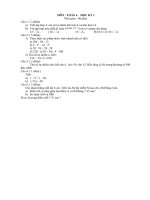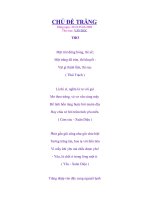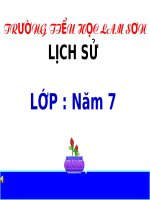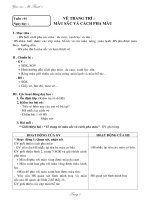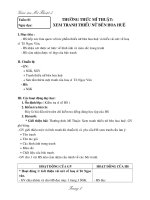Tài liệu How semiconductors are made doc
Bạn đang xem bản rút gọn của tài liệu. Xem và tải ngay bản đầy đủ của tài liệu tại đây (928.87 KB, 55 trang )
How semiconductors are made
Outline
Part 1: Mask design creation
Part 2: Front end Processing
Part 3: Back end processing
Design/mask creation
Circuit design
Photomask creation
Logic Circuit Design / Layout
Design
Based on the development plan, the IC's function and
performance are first decided, and the logic circuit is
designed. During logic circuit design, a logic circuit diagram
is drawn to determine the electronic circuit required for the
requested function. Once the logic circuit diagram is
complete, simulations are performed multiple times to test
the circuit’s operation. If there is no issue with the
operation, the actual layout pattern for the devices and the
interconnects is designed by computer-aided design(CAD),
and a mask pattern is drawn.
Logic Circuit Design / Layout
Design
Photomask Creation
After design of the logic circuit and the layout, a photomask
is required to transcribe the design onto the wafer for use
during front-end processing. The photomask is a copy of the
circuit pattern, drawn on a glass plate coated with a metallic
film. The glass plate lets light pass, but the metallic film
does not. A state-of-the-art mask drawing system is used
for the pattern exposure of the photomask. Due to
increasingly high integration and miniaturization of the
pattern, the size of the photomask is usually magnified four
to ten times the actual size, depending on the irradiation
equipment.
Photomask creation
Wafer fabrication
Deposition
Process 1: Wafer Fab
A thin, circular slice of semiconductor material is
called a "wafer", and is used as the substrate in IC
manufacturing. A high-purity, single-crystal silicon
called "99.999999999% (eleven-nine)" is grown
from a seed to an ingot, after which its ends and
individual wafer discs are sliced off. The wafers are
generally available in diameters of 150 mm, 200
mm, or 300 mm, and are mirror-polished and
rinsed before shipment from the wafer
manufacturer.
Wafer Fab
Process 2:Deposition
When the wafer is ready, the next step is the patterning of
the circuit pattern designed in the "design / mask creation"
step. Before patterning, the wafer is placed in a high-
temperature furnace to make the silicon react with oxygen
or water vapor, and to develop oxide films on the wafer
surface (thermal oxidation). These oxide films are used for
the insulation of transistor gates and for the insulation of
interconnect layers. To develop nitride films and polysilicon
films, the chemical vapor deposition (CVD) method is used,
in which a gaseous reactant is introduced to the silicon
substrate, and chemical reaction with the substrate surface
is prompted by high temperature or plasma. The metallic
layers used in the wiring of the circuit are also formed by
CVD, spattering (PVD: physical vapor deposition), or other
plating methods.
Film oxide
At 900-1200 C with H
2
O or O
2
in oxidation furnace
222
22
H2SiOOH2Si
SiOOSi
+→+
→+
Deposition
Process 3: Photoresist Coating
The lithography method, which irradiates (cho anh
sáng rọi vào)the wafer past a photomask, is used
for patterning. In preparation for this process, a
resin(nhựa) called "photoresist" is coated over the
entire wafer. Photoresist is a special resin similar in
behavior to photography films that changes
properties when exposed to light. A drop of liquid
photoresist is dripped onto the wafer surface as
the wafer is rotated at high speed on the coating
machine, resulting in an approximately 1μm thick
coating.
Photoresist Coating
Masking / Exposure
The photomask created in the "design / mask creation" step
is placed over the photoresist-coated wafer, which is then
irradiated to have the circuit diagram transcribed(sao chép)
onto it. The positions of the wafer and the mask are
adjusted, and then an irradiation device called the "stepper"
is used to irradiate the wafer through the mask with
ultraviolet (UV) light. Where unmasked, the wafer is
exposed to the UV light, and the exposed photoresist
changes chemically. The mask is four to ten times larger
than the actual size of the circuit, so the stepper lens must
be adjusted to 1/4 to 1/10 magnification before being
projected onto the wafer. The procedure is repeated for the
entire surface of the wafer.
The photoresist chemically reacts and dissolves
in the developing solution, only on the parts
that were not masked during exposure
(positive method). Development is performed
with an alkaline developing solution. The
developing solution dissolves the parts of
photoresist that were chemically changed by
exposure to light. After the development,
photoresist is left on the wafer surface in the
shape of the mask pattern. This is called the
"resist pattern".
Development
Etching
Etching" refers to the physical or
chemical etching of oxide films and
metallic films using the resist pattern as
a mask. Etching with liquid chemicals is
called "wet etching" and etching with
gas is called "dry etching". The oxide
films are etched with chemicals (HF
acid), and the metallic films are etched
with plasma.
Etching
Photoresist Stripping
The photoresist remaining on the wafer
surface is no longer necessary after etching is
complete. Ashing by oxygen plasma or the
likes is performed to remove the residual
photoresist. The wafer is also rinsed with an
acidic solution to remove any impurities, such
as metals and organic matters. The steps
from deposition to photoresist stripping are
repeated multiple times to form a complex
circuit pattern on the wafer.
Photoresist Stripping


